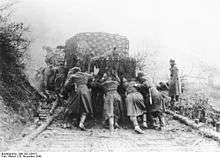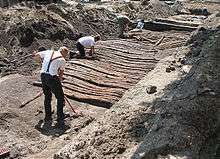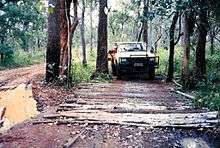Corduroy road


A corduroy road or log road is a type of road made by placing sand-covered logs, sometimes known as "punchings," perpendicular to the direction of the road over a low or swampy area. The result is an improvement over impassable mud or dirt roads, yet rough in the best of conditions and a hazard to horses due to shifting loose logs.
Corduroy roads can also be built as a foundation for other surfacing. If the punchings are buried in wet, acidic, anaerobic soils such as peat or muskeg, they decay very slowly. A few corduroy road foundations that date back to the early 20th century still exist in the United States. One example is the Alaska Highway between Burwash Landing and Koidern, Yukon, which was rebuilt in 1943, less than a year after the original route was graded on thin soil and vegetation over permafrost, by using corduroy, then building gravel road on top. During the 1980s, the gravel was covered with a chip-seal. The late 1990s saw replacement of this road with modern road construction, including rerouting of the entire highway.
In a slang application, corduroy road can also apply to a road in ill repair, having many potholes, ruts, or surface swellings. This should not be confused with a washboard road.
Historical uses


This type of road is known to have been used as early as 4,000 BC with examples found in Glastonbury, England.[1] Compare the puncheon or plank road, which uses hewn boards instead of logs, resulting in a smoother and safer surface. It also was constructed in Roman times.
Corduroy roads were used extensively in the American Civil War in Sherman's march through the Carolinas[2] and in World War II by German and Soviet forces on the Eastern Front.[3]
In the Pacific Northwest corduroy roads built of huge logs without the sand covering were the mainstay of local logging practices and were called skid roads. Two of these, respectively on the outskirts of the milltowns of Seattle and Vancouver, which had become concentrations of bars and working man's slum, were the origin of the more widespread meaning of "skid road" and its derivative skid row, referring to a poor area.
Origin
The name "corduroy road" refers to the road's similar appearance to corduroy fabric.
See also
- Boardwalk
- Duckboards
- Marsden Matting - a 20th-century equivalent for airport runways
- Plank road
- Sweet Track and Post Track
- Timber trackway
References
- ↑ Lay, Maxwell G (1992). Ways of the World: A History of the World's Roads and of the Vehicles that Used Them. Rutgers University Press. p. 43. ISBN 0-8135-2691-4.
- ↑ Grant, Ulysses, Personal Memoirs of U. S. Grant, (c) 1885: Chapter 62
- ↑ Military Improvisations During the Russian Campaign, Chap 5, Center of Military History, US Army
External links
| Wikimedia Commons has media related to Corduroy roads. |
The short film Military Roads (1943) is available for free download at the Internet Archive
